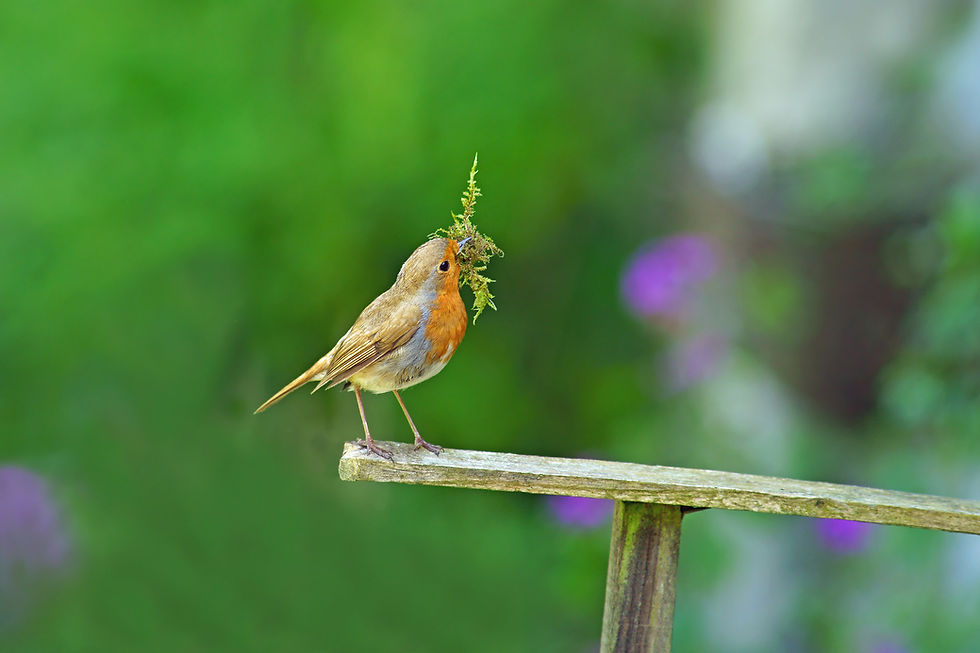The Wonderful World of Nesting Birds
- Mar 29, 2021
- 3 min read
Late February to early August is an exciting time for wildlife fans throughout the UK; it's nesting season! At The Arb Team we love this time of year; the natural world awakens and birds make their homes amongst trees and hedgerows in readiness for their brood!
We take our duty as tree surgeons and advocates of nature very seriously. As professional arboriculturists we know what to look for and how to identify an active nest. Beyond this, we know how to care for the tree, whilst ensuring the nest goes undisturbed. We carry out thorough and consistent checks prior to commencing any garden clearance or tree maintenance work to make sure active nests are preserved and safe. It's a part of our responsibility to preserve the native wildlife of Wales, meanwhile carefully maintaining the natural world in which they live.
The secret life of nesting birds is full of fascinating and intricate routines. The Arb Team takes great pride in understanding the seasonal activity and habits of these private happenings. So, boil the kettle and settle in to find out more about the captivating world of nesting birds.
Birds sit on their eggs to help their young develop... To nurture their chicks, birds will sit on their eggs to incubate them, transferring their own body heat to help the babies grow inside their shells. Many birds will lose their feathers in certain areas to help the heat transfer to the eggs more efficiently, this is known as a 'Brood Patch'. This part of the process can continue for varying amounts of time; Blue Tits will incubate their eggs for only a few weeks, whereas Swans will take months to prepare their babies for hatching! It is intriguing to know that different species of birds have different social rituals over which gender incubates the eggs and when they do it.

Nests are mostly a temporary home...
Birds very rarely return to a nest for a second brood. Even Blackbirds, that can raise up to seven broods in any one season will very rarely use the same nest twice. An interesting and lesser known fact is that birds will recycle and reuse parts of a previous nest to make a new one. Swifts are one of the only exceptions to the rule who will return every year to the same nesting site. Interestingly, it is generally the female of the partnership that will choose a nests location and take the lead of the structural build and sourcing of materials to create the temporary homestead. This is with the exception of one very interesting species: A male Wren will choose the location for, and build several nests within his territory and then escort his partner to each nest, allowing her to choose which one she would prefer to lay her eggs in.
Birds use a great number of materials to make their nests...
A nest can be built in many different places and birds will work in partnership to find a safe, secure and dry space for them to bring their young into the world and nurture them. Popular areas in your garden could be bushes, hedgerows, trees, eave spaces of sheds and outbuildings and, of course, purpose built bird boxes. Once a suitable location is found, birds will begin collecting materials such as moss, twigs, feathers, leaves and even animal hair to build a solid structure that will protect them and keep them warm. Incredibly, some species of birds (Jackdaws and Crows) have even been known to collect and use metal wire to build their nesting space!

Birds come together to sing from their territories just before sunrise...
A glorious result of the UK nesting season is the natural phenomenon known as the 'Dawn Chorus': A time an hour before sunrise when birds will awaken and defend their territories and attract new mates. This truly is one of nature's great performances, not to be missed! The Dawn Chorus will begin in April and climax at its full volume and participation in early May. This delightful cacophony is well worth setting your alarm early for, and reminds us of the importance of preserving the local wildlife.

As specialist professionals in our industry, The Arb Team have the skills required to identify active nests of different species and know how to care for the tree or bush in which they sit. Active nests in the UK are protected by several regulations that encourage the conservation of Britain’s native wildlife. We work with these regulations to successfully maintain the natural habitat by considering more than just the site of the active nests. We know how delicate the ecosystem can be and make sure that any work carried out does not leave a nest exposed to the elements or predators. Speak to a team of reliable professionals today about your maintenance needs and let's work to preserve the natural world together- 01792 885184




Comments